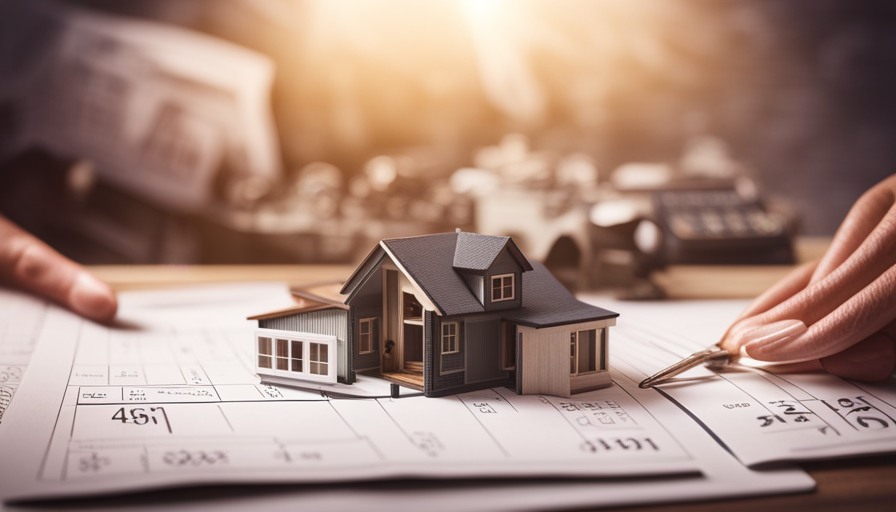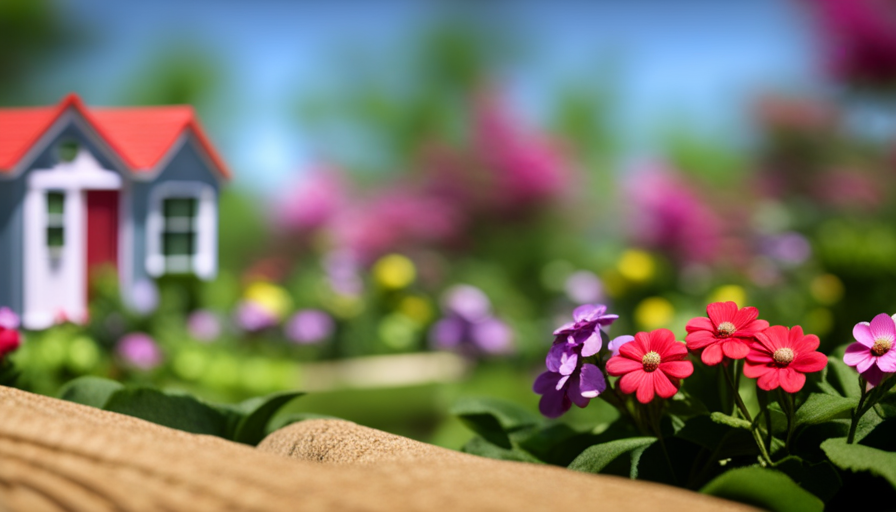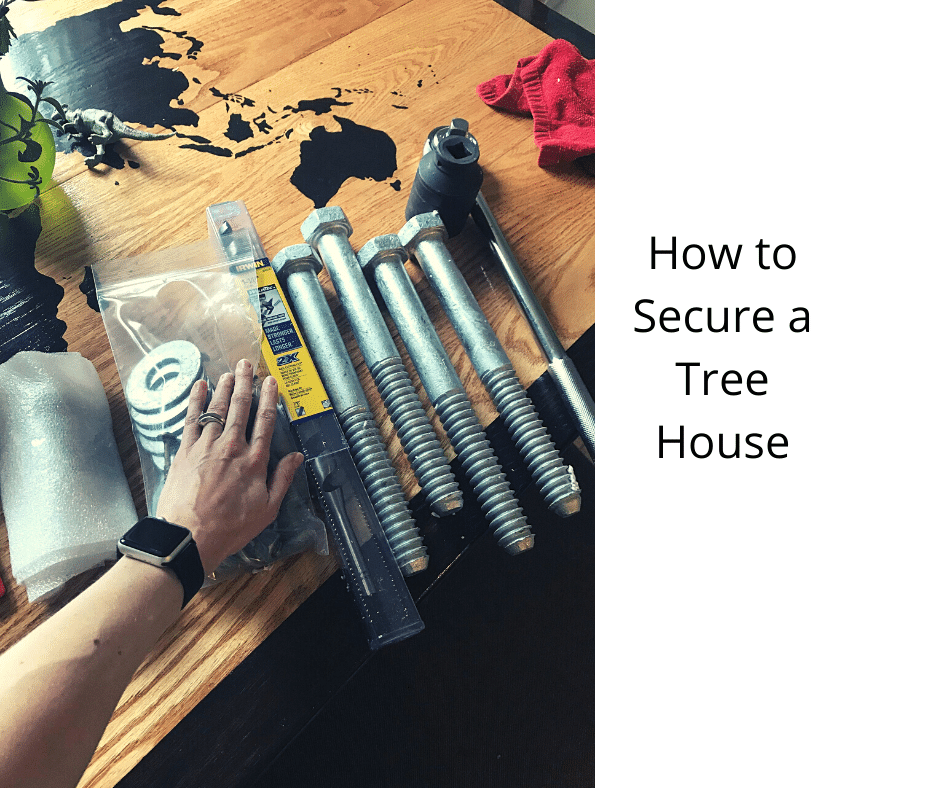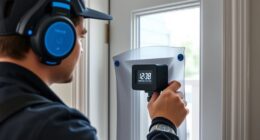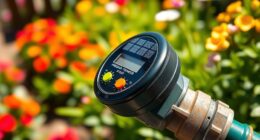A small home loan serves as the crucial tool that unlocks the door to independence and financial self-sufficiency, providing the chance to own your own modest abode.
Just as a bee carefully constructs its hive, so too must we navigate the intricacies of securing a tiny house mortgage.
In this article, I will guide you through the process of how a tiny house mortgage works, step by step. From understanding the benefits to qualifying for a loan, finding a lender, and completing the application process, we will explore each stage with meticulous attention.
Along the way, we will delve into the experience of moving into a tiny house and managing your mortgage, as well as the vibrant and supportive community that awaits you.
So grab your metaphorical hammer and let’s construct a solid foundation for your tiny house dreams.
Key Takeaways
- Tiny house mortgages are loans designed specifically for financing the purchase of a tiny house.
- Owning a tiny house can lead to a simpler and more minimalist lifestyle, reducing both carbon footprint and utility bills.
- Timely payment of a tiny house mortgage can improve credit score, providing long-term financial benefits.
- It is important to thoroughly research mortgage lenders that specialize in tiny house financing, comparing interest rates and loan terms to find the best deal.
What is a Tiny House Mortgage?
So, you’re interested in learning about tiny house mortgages and how they work? Well, let me break it down for you.
A tiny house mortgage is a loan specifically designed for financing the purchase of a tiny house. Unlike traditional mortgages, which are typically used to buy larger homes, a tiny house mortgage is tailored to the unique circumstances of tiny house living.
Living in a tiny house has become increasingly popular in recent years, mainly due to the benefits of downsizing. Tiny houses offer a simpler and more minimalist lifestyle, allowing individuals to reduce their carbon footprint, save money on utility bills, and minimize their overall consumption. However, there are also challenges that come with tiny house living, such as limited space, zoning restrictions, and the need for creative storage solutions.
When it comes to financing a tiny house, a mortgage can provide a practical solution. It allows individuals to spread out the cost of their tiny house over a longer period, making it more affordable and manageable. Additionally, some lenders offer specialized tiny house mortgages that take into account the unique characteristics of tiny homes, such as their portability and lower cost.
Now that we’ve covered the basics of what a tiny house mortgage is, let’s explore the benefits of obtaining one.
Benefits of a Tiny House Mortgage
One of the key advantages of a tiny house mortgage is that it allows you to plant the seeds of your dreams and watch them grow into a flourishing garden of financial stability. Here are some benefits of a tiny house mortgage that make it an attractive option for many individuals:
-
Affordability: Tiny house mortgages often come with lower monthly payments compared to traditional mortgages, making it easier to manage your finances and save for other goals.
-
Impact on credit score: Timely payment of your tiny house mortgage can help improve your credit score over time, opening up more opportunities for future loans and financial endeavors.
-
Tax benefits: Owning a tiny house can come with certain tax advantages, such as deductions on mortgage interest and property taxes, allowing you to keep more money in your pocket.
By taking advantage of a tiny house mortgage, you not only gain the benefits mentioned above but also set yourself up for success in the future.
Now, let’s explore how to qualify for a tiny house mortgage and make your dreams a reality.
How to Qualify for a Tiny House Mortgage
To be eligible for a tiny house mortgage, individuals need to meet certain criteria and demonstrate their financial stability. Qualifying requirements for a tiny house mortgage may vary depending on the lender, but typically include a minimum credit score, a stable income, and a low debt-to-income ratio.
Lenders will also consider the value of the tiny house and its location.
One of the most important qualifying requirements is a minimum credit score. Lenders want to ensure that borrowers have a history of responsible financial behavior. Generally, a credit score of 620 or higher is required to qualify for a tiny house mortgage.
In addition to a good credit score, borrowers need to demonstrate a stable income. This shows lenders that they have the means to repay the mortgage. Lenders will often require documentation of income, such as pay stubs or tax returns.
Another important factor is the debt-to-income ratio. Lenders want to ensure that borrowers are not overburdened with debt and have enough income to cover their mortgage payments. Typically, a debt-to-income ratio of 43% or lower is preferred.
Once individuals meet these qualifying requirements, they can explore different loan options for a tiny house mortgage. These options may include conventional mortgages, government-backed loans, or specialized tiny house loans. Finding a lender for a tiny house mortgage can be the next step in the process.
Finding a Lender for a Tiny House Mortgage
When it comes to finding a lender for a tiny house mortgage, there are a few key points to consider. First and foremost, it’s important to thoroughly research mortgage lenders that specialize in tiny house financing. This will ensure that you find a lender who understands the unique needs and challenges of financing a tiny house.
Additionally, comparing interest rates and terms from different lenders is crucial in order to find the best possible deal for your tiny house mortgage. Taking the time to do your due diligence in these areas will help you make an informed decision and secure the financing you need for your tiny house.
Researching Mortgage Lenders
While researching mortgage lenders, it’s important to consider their interest rates and loan terms. To find the best lender for your tiny house mortgage, start by researching different lenders online and reading reviews from other borrowers.
Look for lenders who specialize in tiny house mortgages or have experience working with alternative housing options. Once you have a list of potential lenders, compare their interest rates and loan terms. Pay close attention to the annual percentage rate (APR), which includes both the interest rate and any additional fees or charges.
Additionally, consider the loan term and whether it aligns with your financial goals and timeline. By thoroughly researching and comparing lenders, you can find the best interest rates and loan terms for your tiny house mortgage, ensuring a smooth and affordable home buying process.
Comparing Interest Rates and Terms
Ready to find the perfect lender for your tiny home loan? Let’s dive into comparing interest rates and loan terms to make sure you get the best deal!
Here are some key factors to consider when comparing interest rates and loan options for your tiny house mortgage:
-
Interest rates: Look for competitive rates that align with your financial goals. A lower interest rate can save you thousands of dollars over the life of your loan.
-
Loan terms: Evaluate the length of the loan and the monthly payment amount. Consider if a shorter term with higher monthly payments or a longer term with lower payments is more suitable for your financial situation.
-
Down payment requirements: Determine how much you need to put down upfront. Some lenders may offer flexible down payment options.
-
Closing costs: Compare the fees associated with closing the loan. These can vary between lenders and impact your overall loan costs.
-
Pre-approval process: Find out if lenders offer pre-approval, which can give you a better understanding of your borrowing power before you start house hunting.
Now that you have a better understanding of comparing interest rates and loan options, let’s explore the next step in the process: the application process for a tiny house mortgage.
The Application Process for a Tiny House Mortgage
To start the application process for a tiny house mortgage, you’ll need to gather all necessary documentation, such as proof of income and credit history, to present to the lender.
For instance, let’s say you’re applying for a tiny house mortgage and you provide the lender with your recent pay stubs and a copy of your credit report to demonstrate your financial stability. It’s important to have these documents organized and readily available to streamline the application process.
Additionally, consider these tiny house mortgage application tips to increase your chances of approval. First, make sure your credit score is in good shape by paying off any outstanding debts or resolving any credit issues. Second, save up for a down payment to show the lender that you are financially responsible. Lastly, be prepared to provide detailed information about the tiny house you are purchasing, including its value and any improvements or renovations you plan to make.
By following these tips and avoiding common mistakes in applying for a tiny house mortgage, such as submitting incomplete or inaccurate information, you can improve your chances of securing a mortgage for your dream tiny home.
Understanding the terms and conditions of a tiny house mortgage is crucial, so let’s explore that next.
Understanding the Terms and Conditions of a Tiny House Mortgage
Once you’ve been approved for a tiny house mortgage, it’s like opening a door to a whole new world of homeownership possibilities. Understanding the terms and conditions of a tiny house mortgage is crucial to ensure you make informed decisions about your loan.
One important aspect to consider is the mortgage rate, which determines the interest you’ll pay on your loan. Typically, tiny house mortgages have lower interest rates compared to traditional mortgages due to the smaller loan amounts. This can result in significant savings over the life of the loan.
Additionally, a tiny house mortgage often offers flexible terms, allowing you to choose a repayment plan that fits your financial situation. Another benefit of a tiny house mortgage is the potential for faster loan payoff. With a smaller loan amount, you may be able to pay off your mortgage quicker, saving you even more money in interest.
Understanding these mortgage rates and benefits can help you make the most of your tiny house mortgage. As you grasp the terms and conditions, you’ll be better prepared to navigate the next step of closing on a tiny house mortgage.
Closing on a Tiny House Mortgage
When it comes to closing on a tiny house mortgage, there are two key points to consider: finalizing the loan agreement and paying closing costs.
Finalizing the loan agreement involves reviewing and signing the necessary documents to officially secure the mortgage. This step is crucial as it legally binds the borrower to the terms and conditions of the loan.
Additionally, paying closing costs is an important financial aspect of closing on a tiny house mortgage. These costs typically include fees for appraisal, title search, insurance, and other administrative expenses.
It is important to be prepared for these costs and understand how they factor into the overall mortgage process.
Finalizing the Loan Agreement
After thoroughly reviewing the loan agreement, I can proceed with finalizing my tiny house mortgage. This step is crucial as it ensures that I fully understand the terms and conditions of the loan.
During this process, I carefully review the repayment plan, including the interest rate, monthly installments, and any potential penalties for early repayment. It is essential to ensure that the loan agreement aligns with my financial capabilities and long-term goals.
Once I’m satisfied with the terms, I can proceed with signing the necessary paperwork and completing any additional requirements from the lender. Finalizing the loan agreement sets the stage for the next step in the process: paying closing costs, which will be discussed in the subsequent section.
Paying Closing Costs
To complete the final steps of your loan agreement, you’ll need to prepare for paying closing costs. These costs are like the icing on the cake, adding the finishing touch to your homeownership journey.
Closing costs typically include appraisal fees, attorney fees, title insurance, and taxes. Additionally, you may need to consider paying mortgage insurance if your down payment is less than 20% of the home’s value.
It’s crucial to choose the right down payment amount that fits your financial situation and goals. A higher down payment can lower your monthly mortgage payments and potentially eliminate the need for mortgage insurance.
Once you’ve sorted out the closing costs and down payment, you’ll be one step closer to moving into your tiny house and enjoying the benefits of a minimalist lifestyle.
Moving into Your Tiny House
Moving into your tiny house is an exciting milestone that allows you to embrace a minimalist lifestyle while enjoying the freedom of homeownership.
One of the first things you’ll want to do when moving into your tiny house is to connect with other tiny house enthusiasts. This can be done through online forums, social media groups, or attending tiny house events. By connecting with others who’ve already made the transition to tiny house living, you can gain valuable insights, tips, and tricks that’ll make your own experience even better.
Once you’ve connected with other tiny house enthusiasts, it’s time to start designing your tiny house layout. Since space is limited, it’s important to optimize every square inch of your home. Consider your needs and prioritize the essential elements of your living space. Whether it’s a lofted sleeping area, a compact kitchen, or a multi-functional living space, careful planning and thoughtful design can make your tiny house feel spacious and functional.
Managing your tiny house mortgage is the next step in your journey. By staying on top of your mortgage payments and budgeting wisely, you can ensure a smooth transition to homeownership. Additionally, exploring ways to reduce your expenses and live a sustainable lifestyle can help you maximize the benefits of living in a tiny house.
Managing Your Tiny House Mortgage
One key aspect of successfully navigating the financial responsibility of a tiny house is effectively managing your mortgage payments. Managing your finances when it comes to your tiny house mortgage requires careful budgeting and planning. Here are some tips to help you stay on top of your payments and ensure financial stability:
-
Create a detailed budget: Start by listing all your monthly expenses and income. This will give you a clear picture of how much you can allocate towards your mortgage payment each month.
-
Set up automatic payments: To avoid late fees or missed payments, consider setting up automatic payments for your mortgage. This way, you can rest assured knowing that your payment will be made on time.
-
Establish an emergency fund: It’s important to have a safety net in case unexpected expenses arise. Set aside some money each month into an emergency fund specifically for your tiny house.
-
Regularly review your finances: Take the time to review your budget and expenses regularly. This will help you identify areas where you can potentially cut back and save more money.
By effectively managing your finances and budgeting for your tiny house mortgage, you can ensure that you stay on top of your payments and maintain financial stability.
In the next section, we will explore the vibrant community that surrounds the tiny house movement.
Exploring the Tiny House Community
When it comes to exploring the tiny house community, there are several key points to consider.
First, connecting with other tiny house owners can provide a wealth of knowledge and support.
Attending tiny house events and workshops is another great way to learn from experts and gain inspiration for your own tiny house journey.
By actively participating in the community, you can build valuable connections and continue to expand your knowledge and skills in the world of tiny living.
Connecting with Other Tiny House Owners
In order to connect with other tiny house owners, it’s helpful to join online communities or attend tiny house meetups where you can share experiences and gain valuable insights.
By joining online forums dedicated to tiny house living, you can connect with a supportive community of like-minded individuals who can offer advice on various aspects of tiny house ownership, from design and construction to legal and financial considerations. These forums often have discussion threads where you can ask questions, share ideas, and learn from others’ experiences.
Additionally, attending tiny house events and workshops provides an opportunity to meet other tiny house owners face-to-face, network, and learn from experts in the field. These events often feature informative sessions, tours of tiny houses, and hands-on workshops to help you further your knowledge and skills in the tiny house community.
Transitioning to attending tiny house events and workshops allows you to take your connection with other tiny house owners to the next level.
Attending Tiny House Events and Workshops
Attending tiny house events and workshops allows me to immerse myself in a supportive community and gain valuable knowledge and skills.
These events are a great way to connect with other tiny house owners, share experiences, and learn from their successes and challenges.
One of the main benefits of attending these events is the abundance of tiny house design inspiration that I can gather. Seeing different layouts, styles, and creative solutions firsthand sparks my imagination and helps me refine my own design ideas.
Additionally, these events often provide information about alternative financing options for tiny houses. I can learn about different mortgage options, grants, and other financial resources that can make owning a tiny home more affordable and attainable.
Overall, attending tiny house events and workshops is an essential part of my journey towards building and owning my own tiny house.
Frequently Asked Questions
Are there any specific requirements for the type of land where a tiny house can be placed with a tiny house mortgage?
When it comes to tiny house mortgage requirements, it’s essential to consider the suitability of the land.
Now, let’s talk about the type of land where a tiny house can be placed with a tiny house mortgage.
While there are no specific rules, it’s crucial to ensure the land is zoned for residential use and meets local building codes.
Additionally, accessibility to utilities such as water, electricity, and sewage systems is essential for a smooth tiny house mortgage process.
Can I use a tiny house mortgage to finance the construction of my own tiny house?
Yes, you can use a tiny house mortgage to finance the construction of your own tiny house. There are various financing options available for this purpose, including traditional mortgages, personal loans, or specialized tiny house loans. However, eligibility criteria may vary depending on the lender and the type of financing you choose. Generally, lenders will consider factors such as your credit score, income, and the value of the tiny house during the approval process.
Are there any limitations on the size or design of a tiny house that can be financed with a tiny house mortgage?
When considering a tiny house mortgage, it’s important to understand any limitations on size and design.
For example, some lenders may have restrictions on the maximum square footage or height of the house.
Additionally, certain design elements like unconventional materials or non-compliant building codes may not be accepted by lenders.
It’s crucial to research and consult with lenders to ensure your tiny house meets their requirements before seeking financing.
What happens if I default on my tiny house mortgage?
If I were to default on my tiny house mortgage, there would be significant consequences.
Firstly, the lender would have the right to initiate foreclosure proceedings, meaning they could seize the property to recover their losses. This would result in the loss of my home.
Additionally, defaulting on my mortgage would have a detrimental impact on my credit score, making it difficult for me to obtain future loans or credit.
It is crucial to make timely mortgage payments to avoid these consequences.
Can I use a tiny house mortgage to purchase a tiny house that is already built and ready to move into?
Yes, you can use a tiny house mortgage to purchase a ready-to-move-in tiny house. The benefits of a tiny house mortgage include the ability to finance your purchase and spread out the payments over time.
However, there are pros and cons to consider. On the positive side, using a mortgage allows you to own a tiny house without paying the full cost upfront. However, you’ll also be responsible for interest payments and may face stricter lending requirements.
Conclusion
In conclusion, getting a tiny house mortgage allows you to embark on an exciting journey of minimalism and freedom. It’s like finding a hidden treasure chest filled with possibilities.
As you close on your mortgage and step foot into your new tiny house, you can’t help but feel a surge of excitement and anticipation. The tiny house community awaits, with its vibrant and welcoming atmosphere, where like-minded individuals come together to share stories and experiences.
So, take the leap and embrace the tiny house lifestyle, where every moment feels like a serendipitous adventure.
Hi, I’m Emma. I’m the Editor in Chief of Tiny House 43, a blog all about tiny houses. While tree houses are often associated with childhood, they can be the perfect adult retreat. They offer a cozy space to relax and unwind, surrounded by nature. And since they’re typically built on stilts or raised platforms, they offer stunning views that traditional homes simply can’t match. If you’re looking for a unique and romantic getaway, a tree house tiny house might just be the perfect option.
